Roasting a whole pig over a large outdoor grill might be all kinds of badass, but it’s not practical for anyone (like myself) who bought a whole pig to eat all by themselves.
So in my last article, I showed how hogs are typically broken down into smaller “primal” cuts by butchers.
Today, I’m going to show you the way around a front limb primal, which contains the following “sub-primal” cuts:
- The butt
- The picnic
- The hock
- The trotter
- Skin
- Fat
From there, I’ll give a quick overview of the most common (and simplest) methods of preparing these cuts, so you can better follow along with my quest to cook and eat an entire pig (or follow along yourself!).
Butt
Don’t be fooled by the name.
The butt comes from the upper part of the front leg of the hog (think the shoulderblade and surrounding area) rather than the rear.
The butt is one of the most prized cuts on the hog, and you’ll often see recipes for pork products such as sausages and rillettes that call for this particular hunk of meat.
But in the spirit of utilizing the whole hog, I’ll focus instead on utilizing the many scraps you get from butchering a whole hog for those dishes.
I plan on smoking the butts whole to make pulled pork.
This is a classic and straightforward way to cook the butt, and can be used in countless ways. And fortunately, there is plenty of this cut to go around!
Picnic
Pity the poor picnic ham.
Unlike the butt, you’ll find relatively few recipes that utilize this cut.
This is too bad, as the picnic can be used for many of the same dishes that the butt can, and can generally be bought for cheaper.
The picnic is the cut that corresponds to the upper leg of the hog, just beneath the butt.
My current plan is to use my picnic hams for grinding up for use in sausage or rillettes.
This is probably the best use of this cut, which doesn’t seem to get a whole lot of attention otherwise.
Hock
Now we’re starting to get obscure!
Hocks are the foreleg of the hog, and are generally neglected in the States, except for the South. (Figures, since for my money, the best food in America comes south of the Mason-Dixon.)
It is full of tough meat, and requires long cooking at low temperatures to become tender. As such, it is best used to give added flavor to soups and stews.
Hocks are also generally smoked before cooking since it adds such a great flavor to slow-cooked dishes, so I will do the same with mine.
Trotter
Now we’re really getting to the fun bits.
Trotters (or pig’s feet, to you), are true recession food.
Due to the whole ermahgershmyfoodcamefromalivingthing! pig’s feet are pretty low in demand, and as a result mighty cheap.
There ain’t a whole lot of meat on pig’s feet, but they are loaded with connective tissue which requires slow cooking, at which point it breaks down into gelatin.
For this reason, pig’s feet are best used to thicken up stocks.
I’m going to use my trotters to make headcheese, then pick them clean to make something known as “trotter gear.” Stay tuned.
Skin and Fat
Few people would think twice about eating chicken skin, but pig skin elicits an “ewwwwwww” from all but the heartiest of food-lovers.
But without skin, we wouldn’t have one of the most delicious pork products known to man!
That’s right, with all the skin found on the front limb (and the entire hog, for that matter), I’ll be making a ton of pork rinds.
While there’s plenty of fat marbled into the meat of a pig, what I’m more interested in here is the thick layer of fat just beneath the skin.
The fat from this part of the animal doesn’t seem to be too terribly prized, and I’ll just plan on rendering it to make cracklin’s and a low-grade form of lard called “schmaltz.”
The fat and skin can be removed in layers from every part of the hog that includes it with a sharp knife.
Notes on Butchering
There are, of course, a thousand and one different ways to butcher this “primal” cut, but I’m going to stick with the simplest and most minimalistic method, utilizing the cuts as I mentioned above.
- First, separate the trotters and hocks off the primal. The hog I bought had the bone cut through these areas already, so I just needed a knife to cut through the meat. If you don’t have these cuts, you might need to break out the saw, or risk dulling your knife cutting through the connective tissue.
- Then, separate the picnic ham and the butt. This is pretty straightforward. You just separate the arm bone from the shoulder blade, and cut through the meat to make two cuts.
- Remove the skin and fat (maybe). If you are going to freeze the picnic or the butt before using, keep the skin and fat on it to protect it from freezer burn. Otherwise, remove them with a knife.
I found the front limb primal to be pretty easy to butcher, particularly since I had the butcher saw through the joints where the trotters and hocks come from.
The anatomy is close enough to your own (foot, lower limb, upper limb, shoulder blade) that finding the joints that separate the sub-primal cuts is straightforward.
In the next article, I’ll take on the rear limb, which is even easier than the front!
Ham’s away!
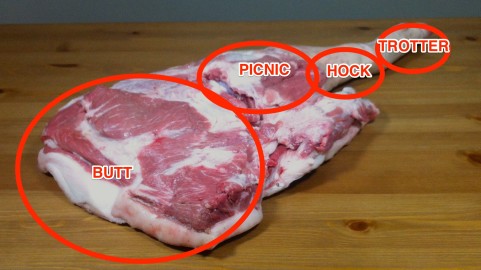
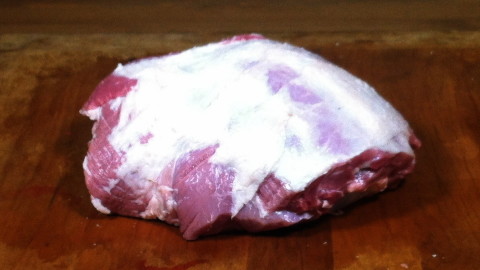
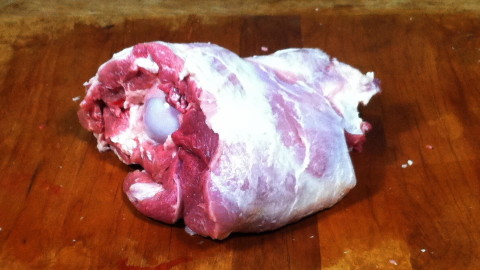
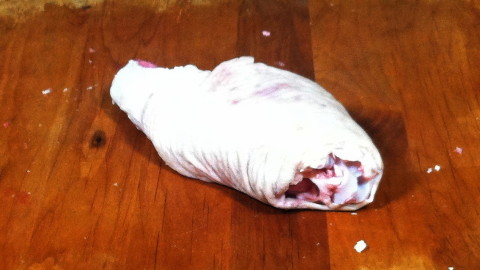
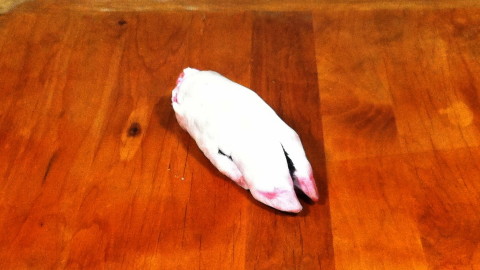
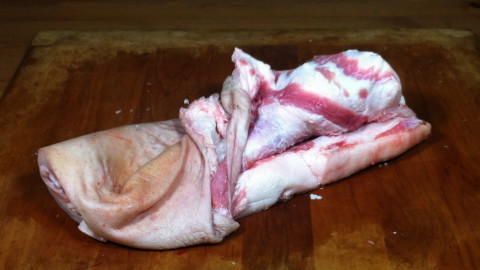
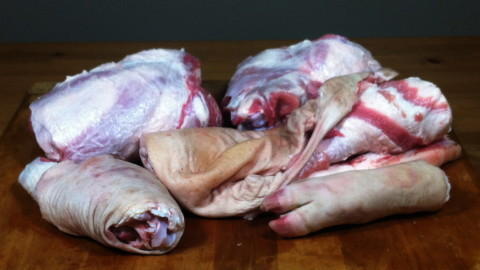
 I'm a science geek, food lover, and wannabe surfer.
I'm a science geek, food lover, and wannabe surfer.
{ 2 comments }
Hey Darrin,
Amazing idea for a serie of posts.
I’m from Brazil and here we use almost all parts of pig, including feet, in a dish called Feijoada (roughly, a beans soup with all kind of pig cuts).
I wish I had a kitchen minimally acceptable to join a journey like yours.
Best wishes and keep those posts coming!
Filipe
Filipe:
Glad you’re enjoying it!
Just Googled Feijoada. Looks delish! 🙂
Comments on this entry are closed.